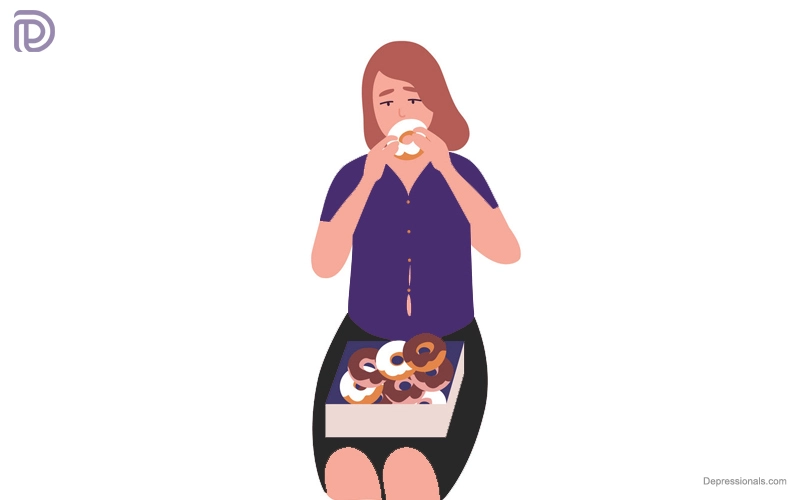Although eating disorders refer to food, they are not limited to it. Often, mental health experts must intervene to change the course of these complex disorders.
This information is found in the fourth edition of the Diagnostic and Statistical Manual of Mental Disorders (DSM-5).
There are six types of eating disorders, and this article discusses the symptoms of each of them.
What are eating disorders?
Approximately 20 million American women and 10 million American men have an eating disorder or have had one at some point in their lives.
An eating disorder is a serious condition caused by persisting eating behaviors that negatively impact your health, your emotions, and your ability to function in important areas of your life. Anorexia, bulimia, and binge eating disorders are among the most common eating disorders.
Many eating disorders result from an excessive focus on body weight, body shape and food, resulting in dangerous eating behaviors. When you experience these behaviors, your body is less likely to receive the proper nutrition. Heart, digestive, bone, teeth and mouth problems can result from eating disorders, as well as other diseases.
Teenage and young adult eating disorders relatively often develop, although other ages may also become affected. When you are treated for an eating disorder, you can return to healthier eating habits and in some cases, reverse serious complications.
Read: Thought Disorder
What causes eating disorders?
Eating disorders are believed to be a result of a variety of factors.
Genetics is one of them. Some twin and adoption studies have shown that eating disorders may be hereditary when they are passed from parents to children.
A few research studies have shown that, on average, if one twin gets an eating disorder, the other has a 50% chance of getting one, too.
Another factor is personality traits. An eating disorder is more likely to develop if you have high levels of neuroticism, perfectionism and impulsiveness.
A person may also be subject to perceived thinness pressures, cultural preferences for thinness and media messages promoting thinness.
Several eating disorders don’t seem to exist in cultures that don’t know the western notions of thinness.
Nonetheless, thinness is highly valued throughout the world, especially in places where culture accepts it as an ideal. However, eating disorders are uncommon in some countries. Therefore, a combination of factors may be responsible for their occurrence.
The recent development of eating disorders has also been linked to differences in brain structure and biology.
There is perhaps some relation between levels of dopamine and serotonin in the brain. Before making strong conclusions, more research is required.
Summary: There are several possible causes of eating disorders. The genetic makeup, brain biochemistry, personality traits and cultural ideals all play a role.
Read: Body Dysmorphic Disorder
Types of eating disorders

1. Anorexia nervosa
Anorexia nervosa is likely the most widely-known eating disorder.
It generally occurs during adolescence or early adulthood and is more common in women than in men.
Although anorexics are dangerously underweight, they expect themselves to be overweight. People who are overweight tend to restrict calories, eat certain types of foods less often and monitor their weight constantly.
Anorexia nervosa symptoms include:
- Comparing your weight to that of similar-sized and aged people
- Dietary restrictions
- Underweight people who are unable to gain weight, even though they think they should gain weight
- Lack of commitment to maintaining a healthy weight and a relentless quest for thinness
- Self-esteem is heavily influenced by body weight or perceived body shape
- Denial of being seriously underweight, as well as distorted body image
There are also often symptoms of obsessive-compulsive disorder. The irrational obsession with food is often a symptom of anorexia, and some may even hoard food or collect recipes.
Also, these individuals may be averse to eating in public and may have strong control over their environment, making it difficult to be spontaneous.
Officially, anorexia can be divided into two types – either a restricting type or a binge and purge type.
Dieters, fasters, or excessive exercise are the methods they use to lose weight.
People with this type of eating disorder may eat too little or consume large portions of food. After eating, both types of people purge their systems with activities like vomiting, taking laxatives, pressing themselves to extremes or exercising excessively.
The body can suffer a lot of damage from anorexia. The skin affected by it may experience hair and nail thinning and brittleness over time, and fine hair may grow on every surface of the body.
Death can result from anorexia in severe cases because the heart, brain, or multiple organs fail.
The physical symptoms of anorexia nervosa include having a limited intake of food or compensating for it with various purging behaviors. When severely underweight, they feel intense anxiety about gaining weight.
Read: Emotional disorders
2. Bulimia nervosa
One of the well-known eating disorders is bulimia nervosa.
It seems to be less common among men than among women and develops during adolescence and early adulthood like anorexia.
A person who suffers from bulimia frequently eats a great deal of food over a few days or weeks.
An individual usually becomes painfully full after each binge eating episode. It is common for the person to feel as if they are unable to control how much they are eating or stop eating during a binge.
A person can binge on anything, but usually, he or she will binge on foods they normally avoid. After eating excessive calories and having stomach discomfort, individuals with bulimia purge to compensate.
Purging commonly involves forced vomiting, enemas, fasting, diuretics, laxatives and excessive exercise.
Anorexia nervosa can display very similar symptoms to binge eating or purging forms of the disorder. In contrast, people with bulimia generally do not become underweight while they remain relatively normal weight.
These are some of the common symptoms of bulimia nervosa:
- Frequently bingeing with a sense of controllessness
- Purging to avoid gaining weight is inappropriate behavior that occurs repeatedly
- Body shape and weight are overly influential on self-esteem
- Although they are a normal weight, they fear gaining weight
Bulimia can cause an inflamed throat, inflammation of the salivary glands, worn teeth enamel, decay, acid reflux, digestive disturbances, dehydration and hormonal imbalances.
An imbalance of salts, potassium, and calcium can also be caused by bulimia in severe cases. Heart attacks and strokes are caused by this.
The main symptom of bulimia nervosa is overeating fast followed by purging. Even though their weight is normal, they are afraid of gaining weight.
Recommended read: Sociopath
3. Binge eating disorder
In the United States, binge eating disorder is estimated to be among the most common eating disorders.
As an adolescent or early adult, it can also occur later in life. This disorder exhibits symptoms similar to bulimia or anorexia with binge eating.
Their binges are typically intense and they feel out of control as a result of consuming extremely large amounts of food. Binge eating disorders are not accompanied by calorie restriction or purging activities such as vomiting or excessive exercise.
The following are common symptoms of binge eating disorder:
- Despite not feeling hungry, eating large quantities of food rapidly and in secret
- Being unable to control eating during binge episodes
- When thinking about binge eating, one may feel shame, disgust or guilt
- Purging behaviors, such as excessive exercise, vomiting, calorie restriction or laxatives and diuretics cannot be used to compensate for binging
Obese or overweight individuals often suffer from binge eating disorders. As a result, they may be exposed to the risk of excess weight-related medical complications, such as heart disease, strokes and type 2 diabetes.
Binge eating disorders cause people to consume large quantities of food uncontrollably and regularly. They do not purge like people with other eating disorders.
Read: 15 Simple Tips to Stop Binge Eating
4. Pica
Pica is another eating disorder in which you eat things that aren’t considered food.
Patients with pica are insatiably interested in outside substances such as ice, dirt, soil, chalk, soap, paper, hair, cloth, wool, pebbles, laundry detergent or cornstarch.
Children, adolescents, and adults may suffer from pica. Accordingly, this disorder is usually found in children, pregnant women, and people with mental disabilities.
A person with pica is more likely to suffer poisoning, infections, stomach injuries and nutritional deficiencies. Ingestion of certain substances can cause pica, which can be fatal.
If someone eats non-food substances as part of their culture or religion, it must not be considered pica. Peers must also not consider it an acceptable practice.
The eating of non-food substances is the craving and behavior of individuals with pica syndrome. Those with mental disabilities, children, and pregnant women are particularly susceptible to this disease.
Related: Pica in Pregnancy
5. Rumination disorder
One of the newly recognized eating disorders is rumination disorder.
It refers to the act of chewing and swallowing food before it is regurgitated, then chewing it again before being swallowed or spit out again.
Rumination usually occurs after eating within 30 minutes. It’s not a medical condition like reflux.
It can affect a child in infancy, a child in childhood, or an adult in adulthood. It usually develops between the ages of 3-12 months in infants and disappears on its own. Therapy is usually required to resolve the condition in children and adults.
It is possible to die from severe malnutrition and weight loss caused by rumination disorder in infants if left untreated.
People who suffer from this disorder restrict how much food they consume, especially in public. This could result in them losing weight and becoming underweight.
People of all ages can suffer from ruminative disorder. Food recently swallowed by people with the condition is regurgitated. It is then chewed again and either swallowed or spit out.
Read: Body-Focused Repetitive Behavior
6. Avoidant/restrictive food intake disorder
Avoidant/restrictive food intake disorder (ARFID) is the new name for a long-standing illness.
Previously known as a “feeding disorder of infancy and early childhood,” which was reserved for children under 7 years old, “feeding disorder of childhood” has been replaced by the new term.
Though ARFID usually develops during childhood or adolescence, it can also persist into adulthood. Also, it affects both men and women equally.
People with this disorder experience an altered sense of taste, smell, color, texture or temperature, which causes them to be indifferent to food.
Common symptoms of ARFID include:
- Insufficient nutrition as a result of restricting or avoiding food intake
- Socially inconvenient eating habits such as eating in private
- Poor weight or height for age or weight loss
- Deficiencies in nutrients or tubal dependency
An important point to note is that AFID is more than just child picky eating and low food intake in seniors.
Furthermore, it does not include avoiding or restricting foods based on religious or cultural practices, or due to lack of availability.
Undereating is one of the symptoms of ARFID. This may be because people aren’t curious about food or dislike certain foods for how they look, smell or taste.
Check all: Psychological Disorders
Other eating disorders
There are also eating disorders that are less well-known or less common than the ones above. There are generally three types of these:
- Purging disorder: When someone with purging disorder tries to gain or lose weight, they often rely on purging behaviors, such as vomiting, laxatives and diuretics. Their behavior is not binge-like.
- Night eating syndrome: It is common for sufferers of this syndrome to eat excessively, often after they wake up from sleep.
- Another specific feeding or eating disorder (OSFED): Despite not being listed in the DSM-5, this encompasses any other condition that has symptoms similar to those of an eating disorder but doesn’t fall into any of the categories discussed above.
Orthorexia is one of the disorders that may currently fall under OSFED. Orthorexia has been increasingly mentioned in the media and scientific studies, but it is not yet recognized as a distinct eating disorder by the current DSM.
In orthorexia, a person tends to obsessively focus on eating healthy to the point where it disrupts their daily routines.
The affected person may eliminate entire food groups out of fear they are unhealthy. An increased risk of malnutrition, severe weight loss, and emotional distress can result from these events.
Weight loss is rarely the focus of individuals with orthorexia. They judge their self-worth, identity, or satisfaction based on how well they follow their own diet rules.
Currently, night eating syndrome and purging disorder are not as well understood as eating disorders in general. As stated above, orthorexia belongs in the OSFED category since it doesn’t fall under any other category
Read: How to Stop Late Night Eating
The bottom line
By analyzing the categories above, you can gain a better understanding of how eating disorders affect people and dispel many myths regarding them.
An eating disorder is a mental health condition that usually requires treatment. Leaving them untreated can also be harmful.
Consider seeking help from a healthcare practitioner who specializes in eating disorders if you have an eating disorder or know someone who might have one.






May I request more information on the subject? All of your articles are extremely useful to me. Thank you!
How can I learn more about it?
Thank you for writing about this topic. Your post really helped me and I hope it can help others too.
Thanks for your help and for posting this article. It’s been great.
May I have information on the topic of your article?
Thank you for writing this post!
Many thanks for your post right here.
We are a group of volunteers and starting a new scheme in our community. Your site provided us with helpful information to work on. You’ve done an impressive activity and our whole community will be grateful to you.
Nice blog here! Also your site loads up fast! What host are you using? Can I get your affiliate link to your host? I wish my website loaded up as quickly as yours lol
I?m impressed, I need to say. Actually hardly ever do I encounter a blog that?s both educative and entertaining, and let me tell you, you’ve got hit the nail on the head. Your idea is excellent; the difficulty is something that not sufficient individuals are talking intelligently about. I am very joyful that I stumbled throughout this in my search for something relating to this.
Once I initially commented I clicked the -Notify me when new comments are added- checkbox and now every time a remark is added I get 4 emails with the same comment. Is there any method you may remove me from that service? Thanks!
Thanks for the tips shared through your blog.
Thanks a bunch for sharing this with all of us you actually know what you are talking about! Bookmarked. Please also visit my site =). We could have a link exchange agreement between us!
Thanks for expressing your ideas.
Thank you for providing me with these article examples. May I ask you a question?
I really appreciate your help
Your articles are incredibly helpful to me. Thank you! May I request more information?
I used to be very pleased to find this net-site.I needed to thanks for your time for this wonderful learn!! I positively enjoying each little bit of it and I have you bookmarked to check out new stuff you blog post.
Thank you for your post. I really enjoyed reading it, especially because it addressed my issue. It helped me a lot and I hope it will help others too.
Thanks for sharing these wonderful articles. Cheers
Remarkable things here. I am very happy to peer your article. Thanks a lot and i’m looking forward to contact you. Will you kindly drop me a mail?
Thank you for sharing this article with me. It helped me a lot and I love it.
An impressive share, I just given this onto a colleague who was doing a bit of evaluation on this. And he in truth bought me breakfast because I discovered it for him.. smile. So let me reword that: Thnx for the deal with! However yeah Thnkx for spending the time to discuss this, I really feel strongly about it and love reading more on this topic. If possible, as you become expertise, would you thoughts updating your weblog with extra details? It is highly useful for me. Huge thumb up for this blog post!
I have been surfing on-line greater than 3 hours these days, yet I by no means found any attention-grabbing article like yours. It?s beautiful price enough for me. In my opinion, if all web owners and bloggers made good content as you did, the web can be much more helpful than ever before.
It?s laborious to find educated people on this matter, however you sound like you understand what you?re talking about! Thanks
You’ve been a great help to me. Thank you!
What are your articles about? Please tell me more.
What is it about? I have some questions dude.
Thank you for being of assistance to me. I really loved this article.
Thank you for your articles. They are very helpful to me. Can you help me with something?
You’ve been great to me. Thank you!
I would like to know more about this subject if you don’t mind.
I want to thank you for your assistance and this post. It’s been great.
I would like to know more about this subject if you don’t mind.
You helped me a lot by posting this article and I love what I’m learning.
You’ve been really helpful to me. Thank you!
You’ve been a big help to me. Thank you!
Please tell me more about your excellent articles
Thanks for your help and for posting this. It’s been great.
Thank you for your post. I really enjoyed reading it, especially because it addressed my issue. It helped me a lot and I hope it will help others too.
Thank you for sharing this article with me. It helped me a lot and I love it.
Thank you for your articles. They are very helpful to me. Can you help me with something?
I have to thank you for this article
I must say you’ve been a big help to me. Thanks!
Thank you for your excellent articles. May I ask for more information?
You’ve been very helpful to me. Thank you!
You’ve been very helpful to me. Thank you!
Your articles are incredibly helpful to me. Thank you! May I request more information?
Can you write more about it? Your articles are always helpful to me. Thank you!
Your articles are extremely helpful to me. May I ask for more information?
Please answer my question. How can i contact you regards this article?
Please tell me more about your excellent articles
The articles you write help me a lot and I like the topic
Thank you for your articles. I find them very helpful. Could you help me with something?
Thank you for writing about this topic. Your post really helped me and I hope it can help others too.
Thanks for writing this article. I enjoy the topic too.
Dude these articles have been really helpful to me. They really helped me out.
Good write-up, I am regular visitor of one?s blog, maintain up the excellent operate, and It is going to be a regular visitor for a long time.
Thanks for your post.
ok mark your weblog and check again here frequently. I’m quite certain I?ll learn a lot of new stuff right here! Good luck for the next!
I do not even know how I ended up here, but I thought this post was good. I don’t know who you are but definitely you are going to a famous blogger if you are not already 😉 Cheers!
I have read so many posts on the topic of the blogger lovers however this post is really a pleasant piece of writing, keep it up.
Howdy! I could have sworn I’ve been to this blog before but after browsing through some of the post I realized it’s new to me. Nonetheless, I’m definitely delighted I found it and I’ll be book-marking and checking back frequently!
Thanks for the helpful post.
You completed various good points there. I did a search on the subject and found most folks will agree with your blog.
Thank you so much for the great article, it was fluent and to the point. Cheers.
Howdy! I could have sworn I’ve been to this blog before but after browsing through some of the post I realized it’s new to me. Nonetheless, I’m definitely delighted I found it and I’ll be book-marking and checking back frequently!
Thanks for the auspicious writeup. It if truth be told was once a leisure account it. Look advanced to more delivered agreeable from you! By the way, how can we keep in touch?
I visit each day a few sites and blogs to read content, but this blog offers quality based writing. I like the valuable information you provide in your articles. I’ll bookmark your weblog and check again here frequently. I’m quite certain I will learn lots of new stuff right here! Best of luck for the next!
Hey there! I just wanted to ask if you ever have any trouble with hackers? My last blog (wordpress) was hacked and I ended up losing months of hard work due to no data backup. Do you have any solutions to prevent hackers?
Good day! I know this is kinda off topic but I’d figured I’d ask. Would you be interested in exchanging links or maybe guest authoring a blog post or vice-versa? My blog goes over a lot of the same topics as yours and I believe we could greatly benefit from each other. If you happen to be interested feel free to shoot me an email. I look forward to hearing from you! Terrific blog by the way!
Heya i am for the primary time here. I came across this board and I find It truly helpful & it helped me out a lot. I hope to provide something again and aid others such as you helped me.
Hey there would you mind letting me know which hosting company you’re working with? I’ve loaded your blog in 3 completely different browsers and I must say this blog loads a lot faster then most. Can you recommend a good internet hosting provider at a honest price? Thanks a lot, I appreciate it!
Hi! I know this is kinda off topic however I’d figured I’d ask. Would you be interested in trading links or maybe guest writing a blog article or vice-versa? My site discusses a lot of the same topics as yours and I feel we could greatly benefit from each other. If you’re interested feel free to send me an email. I look forward to hearing from you! Awesome blog by the way!
Pretty section of content. I just stumbled upon your weblog and in accession capital to assert that I get in fact enjoyed account your blog posts. Anyway I will be subscribing to your augment and even I achieve you access consistently rapidly.
Hola! I’ve been following your website for some time now and finally got the bravery to go ahead and give you a shout out from Austin Tx! Just wanted to mention keep up the great work!
Hi there would you mind letting me know which hosting company you’re using? I’ve loaded your blog in 3 different browsers and I must say this blog loads a lot faster then most. Can you suggest a good web hosting provider at a reasonable price? Thanks, I appreciate it!
Almost all of the things you mention happens to be supprisingly legitimate and it makes me wonder why I hadn’t looked at this in this light before. This particular article truly did switch the light on for me as far as this specific subject goes. Nonetheless at this time there is actually just one issue I am not necessarily too comfortable with and whilst I attempt to reconcile that with the core theme of the point, permit me see exactly what all the rest of the visitors have to say.Well done.
Thanks for these tips.
Excellent beat ! I wish to apprentice while you amend your site, how can i subscribe for a weblog site?
Excellent website. A lot of helpful information here. I’m sending it to a few pals and also sharing in delicious. And obviously, thank you in your sweat!
Great info and straight to the point. I don’t know if this is in fact the best place to ask but do you guys have any thoughts on where to hire some professional writers? Thx 🙂
Thanks for each of your efforts on this web page. Ellie enjoys getting into internet research and it’s really easy to see why. We all learn all relating to the powerful tactic you present very useful things by means of your web blog and encourage contribution from other ones on this concept plus my girl is in fact understanding a great deal. Take pleasure in the rest of the new year. Your conducting a fantastic job.
Thx for the good suggestions I gained from your blog.
Thanks for your publication.
you’ve a fantastic blog here! would you like to make some invite posts on my blog?
After I originally commented I clicked the -Notify me when new comments are added- checkbox and now each time a remark is added I get four emails with the same comment. Is there any method you may remove me from that service? Thanks!
Today, with the fast way of living that everyone is having, credit cards have a huge demand throughout the market. Persons coming from every area are using the credit card and people who are not using the card have made up their minds to apply for 1. Thanks for giving your ideas in credit cards.
There are certainly loads of details like that to take into consideration. That could be a great point to deliver up. I provide the thoughts above as common inspiration however clearly there are questions just like the one you carry up the place a very powerful thing might be working in honest good faith. I don?t know if best practices have emerged round things like that, however I am sure that your job is clearly identified as a good game. Each boys and girls really feel the affect of only a moment抯 pleasure, for the rest of their lives.
I think other web-site proprietors should take this website as an model, very clean and wonderful user genial style and design, as well as the content. You’re an expert in this topic!
When I originally commented I clicked the “Notify me when new comments are added” checkbox and now each time a comment is added I get several emails with the same comment. Is there any way you can remove me from that service? Many thanks!
Hey! I simply want to give a huge thumbs up for the nice data you may have here on this post. I can be coming back to your weblog for more soon.
I’m impressed, I need to say. Really hardly ever do I encounter a weblog that抯 both educative and entertaining, and let me inform you, you’ve got hit the nail on the head. Your idea is excellent; the issue is one thing that not enough people are talking intelligently about. I am very glad that I stumbled throughout this in my search for one thing relating to this.
whoah this weblog is magnificent i love studying your posts. Stay up the great paintings! You already know, many persons are looking around for this info, you can aid them greatly.
Excellent beat ! I wish to apprentice while you amend your site, how can i subscribe for a weblog site?
You are my breathing in, I have few web logs and occasionally run out from brand :). “Fiat justitia et pereat mundus.Let justice be done, though the world perish.” by Ferdinand I.
The article is good. Thank you so much.
It’s appropriate time to make some plans for the future and it is time to be happy. I have read this post and if I could I wish to suggest you few interesting things or suggestions. Maybe you can write next articles referring to this article. I wish to read even more things about it!